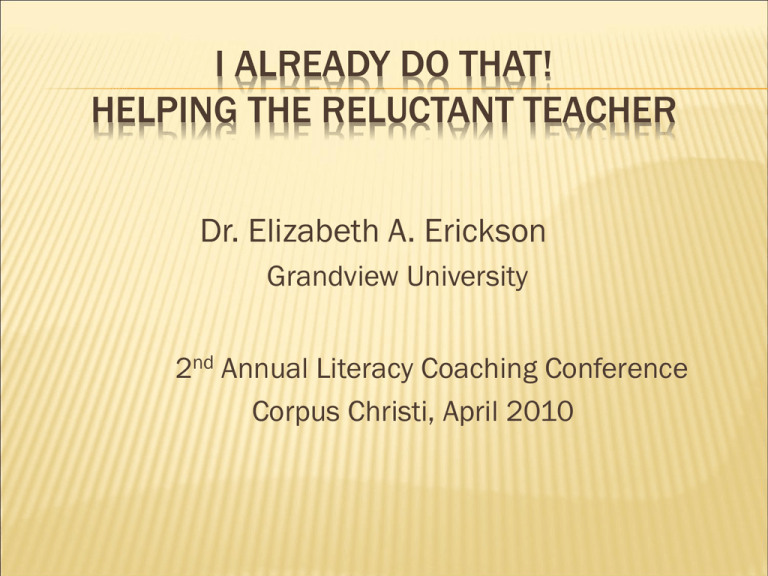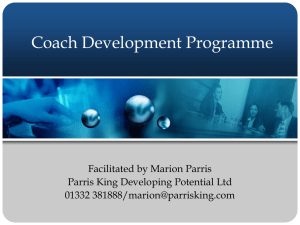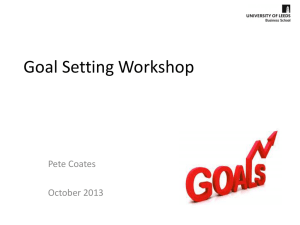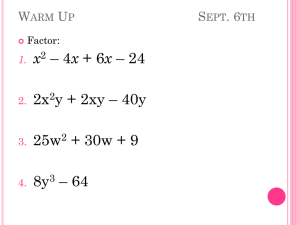I Already Do That! Helping the Reluctant Teacher 2nd Annual LC
advertisement

I ALREADY DO THAT! HELPING THE RELUCTANT TEACHER Dr. Elizabeth A. Erickson Grandview University 2nd Annual Literacy Coaching Conference Corpus Christi, April 2010 SESSION GOALS What research states about secondary coaching My journey as first year coach The context Challenges Successful strategies PURPOSES OF LITERACY COACHING (CASEY, 2006) Help design and facilitate professional development Work with teachers, demonstrating instructional strategies and guiding teachers as they model Evaluate students’ literacy needs and collaborate with teachers on how to meet those needs Provide teachers with opportunities to learn from each other IRA CRITERIA (2004) Be excellent classroom teachers and teachers of reading Be able to observe, model, and provide feedback to teachers Be knowledgeable about reading processes, acquisition, assessment, and instruction Have experience working with teachers to improve instructional practices Be excellent presenters to lead groups, facilitating reflection and change. RESEARCH STATES . . . “ . . .the advent of literacy coaching occurred before a significant body of research could offer guidance concerning how to implement it to its optimal advantage” (Walpole, McKenna, draft). “. . .coaching is situated and will take on new and different relational dynamics in different contexts” (Rainville, Jones, 2008, p. 440) “ . . . coaching is embedded within schools and classrooms and is responsive to the specific challenges faced by teachers in their daily work with students” (Steckel, 2009, p. 14). “It is essential to consider coaching in the context in which it occurs. The embedded nature of coaching makes it a powerful agent of change but also often frustrates its success” (Steckel, 2009, p. 14). MY STORY: CONTEXT The smallest (1170 students) HS of five in an urban setting District Graduation rate-82% ITEDS- city (59.3) this school ( 52.8 ) on reading, 2009 4th years SINA, first year Title I Poverty rate 74.6% 41 % White/59% Non White (9% ELL) Bottom 5% of student achievement in the state MY STORY-THE CHALLENGE Bring reading scores to proficiency Minimum “safe harbor” Scores from 52.8 – 57.5 Proficient Goal 79.3 Work with primarily English/reading faculty MY VISION ‘Blank page’ to start-little direction Team building Vision School is an exciting place of thinking & inquiry Work with students’ strengths Curriculum should teach big ideas, led by essential questions to explore All reading should be on individuals’ levels with as much individual choice as possible within the concepts of curriculum Textbooks should be used as resources only TO START . . . Met with English department on their needs and desires Collected baseline data on observations in all English classrooms Asked faculty to be ‘invited in’ OBSERVATION DATA Organization of the lesson Are strategies evident? Are the vocabulary lessons within tier two? Is there guided practice? Are students engaged? Classroom environment Is student work displayed? PROBLEMS? Don’t ever tell me what to do I already do that! We did that 20 (30) years ago Do you have to come in my room? OK, I complied. Anything else? I have a reading endorsement It is not us, it is the kids. Fix the kids. SUCCESSFUL STRATEGIES Teacher Conversations School had 25 minute advisory daily, not used 1-2x/month facilitated conversations on the schoolwide vocabulary building goal Group grounding Modeled 1 strategy Gave theory Exit slips varied depending on what I heard from faculty What three aspects in your classroom would improve student achievement? Based on ‘Am I looking in a mirror or a window” activity & comments like “just get the kids to work” Results Comments coded, then created into an activity for the second PD session using word sorts vocabulary SECOND SESSIONContinued with theory on tiered words Had faculty practice using own text, types of words to teach Exit slip, ‘What is your role in PD?” Results Very ‘politically correct’ We know what is expected- how do we model? THIRD SESSION Sharing of vocabulary strategies that are currently modeled and are working in your classroom Started having faculty share good ideas and student work Exit slip, “How comfortable do you feel about addressing the reading needs of your students? If not comfortable, sign up for a conference at your convenience Results-6 new faculty wanted help! FOURTH SESSION More sharing of vocabulary activities from faculty Modeled double-entry journals Kicked off a reading incentive Exit slip, “If you were to sign up for training, what area would you prefer?” Gave handout with several strategies we could model THREE READING INCENTIVES First-modeled thinking while I read strategies for faculty Gave 6 bookmarks with 4 questions Ask students to read 2 books of choice in 5 weeks using 6 bookmarks for each book & discussing the books with advisory teachers Modeled in two advisories Results-32 students ‘won’ a trip to a book store and chose a $10. book with grant money 2ND & 3RD INCENTIVE Modeled double-entry journals for faculty Gave students 2 weeks to read one book of choice, fill out 6 entries, and discuss with advisory teacher Results-55 ‘winners’ Third incentive pending---using a metacognitive ‘reading map’ created by the 9th gr. reading t’er HALF-DAY PD Student engagement Modeled use of texting from cell phones to journal clickers anticipatory sets to start lessons word ladders BOOK FAIR Had the first Scholastic Book Fair for this school Scholastic piloted a high school Teamed with local university Results Much excitement from students Earned $550. for books to place in classrooms Teachers who create a thematic mult-text unit will receive book sets PARENT NIGHT Still pending Slip Knot lead singer, ‘Cory’ is a native of this city Asked him to share his past and how graduation became possible Will add ‘centers’ for younger children, places for our reading incentive winners to share read alouds from books purchased by school 11TH GRADE IRIS Needed 11th test data to make safe harbor Created 3 IRIs at grade level Showed students data from each, modeled how I think as I read & how to use QAR for test questions Discussed percent/percentile and sustainability (if you can do well on one IRI, sustain efforts for the ITEDs Motivated students to do well for themselves and for the school (we compete for sports . . .) BOTTOM LINE . . . Build bridges with faculty Model ideas, show theory Get students excited Get resources for teachers Get teachers to share successes Offer to teach a class, so teachers can observe each other Be very visible in halls and classrooms REFERENCES Casey, K. (2006). Literacy coaching. The essentials. Portsmouth, NJ: Heinemann. International Reading Association. (2004). The role and qualifications of the reading coach in the United States. Newark, DE: International Reading Association. Rainville, K. N. & Jones, S. (2008). Situated identities: Power and positioning in the work of a literacy coach. The Reading Teacher, 61(6), pp. 440–448. International Reading Association. QUESTIONS?







